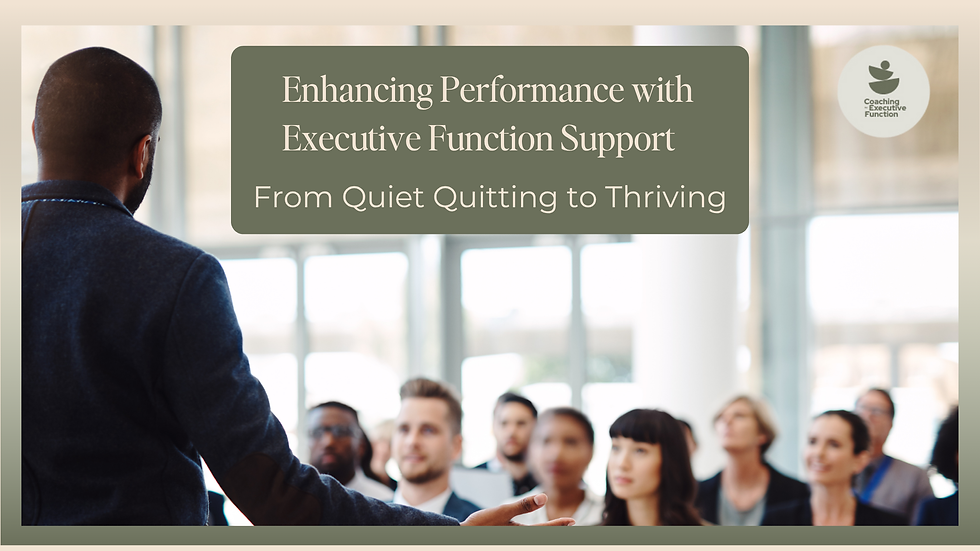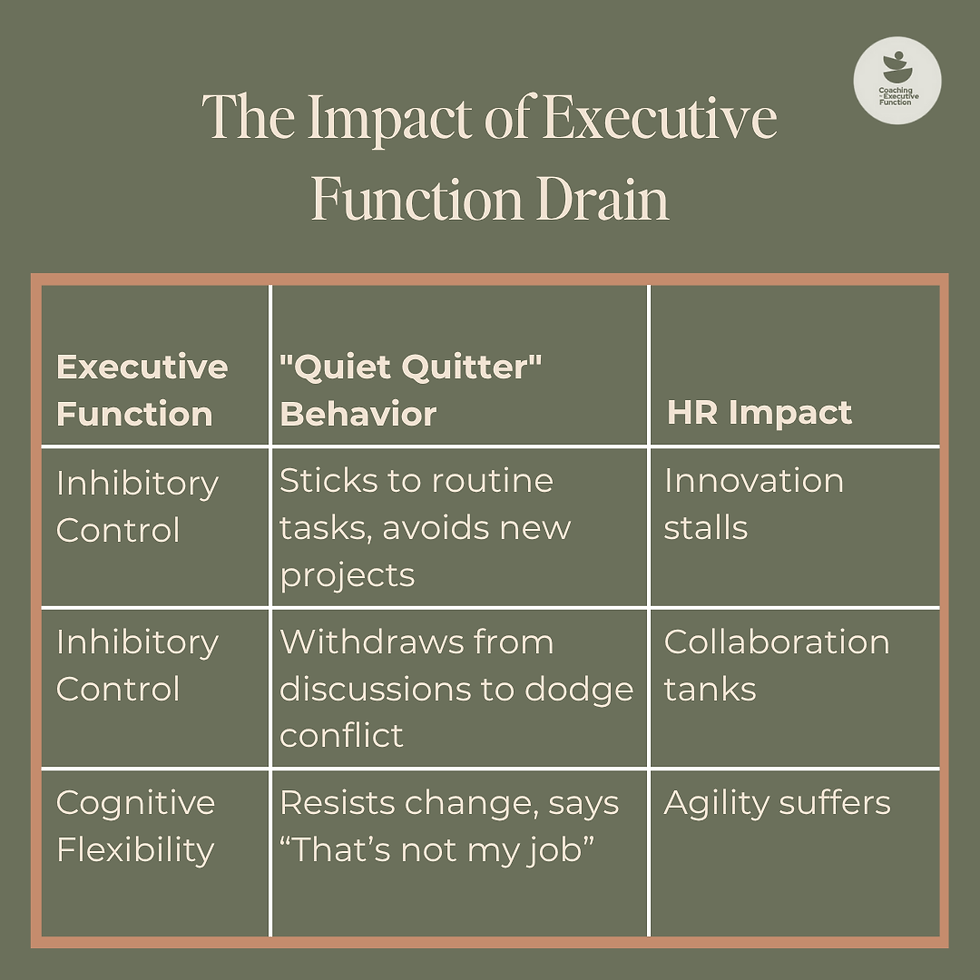Executive Function Support: Enhancing Performance and Engagement.
- Jacquelyn Harper MS, OTR/L, ADHD-RSP

- Jul 24
- 3 min read
From Quiet Quitting to Thriving: Executive Function Support
"Quiet quitting" isn't usually laziness; it's a coping strategy. When employees feel chronically overloaded, under-supported, or cognitively scattered, they protect their bandwidth by dialing back to the bare minimum. The real culprit is often executive-function strain breakdowns in working memory, inhibitory control, and cognitive flexibility that sap focus, energy, and initiative. Addressing this strain with executive function support is key to finding quiet quitting solutions and boosting employee engagement.

How Lack of Executive Function Support Undermines Engagement.
When the cognitive gas tank is empty, engagement is the first casualty. This table illustrates how executive function challenges manifest and impact HR outcomes:
Executive Function | Early Warning Sign | “Quiet Quitter” Behavior | HR Impact |
Working Memory | Re-asking for details, missing minor steps | Sticks to routine tasks, avoids new projects | Innovation stalls |
Inhibitory Control | Snappish emails, eye-rolling in meetings | Withdraws from discussions to dodge conflict | Collaboration tanks |
Cognitive Flexibility | Struggles with pivots or reprioritization | Resists change, says “That’s not my job” | Agility suffers |

Four Strategies for Executive Function Support.
Here are four executive function support strategies that can significantly boost engagement:
Visual Workflows: Shared Kanban boards or digital dashboards that make priorities and progress visible. This externalizes tasks, offloading working memory and sparks dopamine as each card moves to “Done”. This helps boost employee engagement and reduces quiet quitting through visual project management.
Two-Tier Deadlines: Implement an internal draft date and an external final date. This creates a buffer for review, limits fire-drills, and protects inhibitory control from last-minute stress spikes.
Focus Sprints + Micro-Recovery: Encourage 90-minute deep-work blocks followed by a five-minute break (stretch, breathe, step outside). This mirrors natural ultradian rhythms, sustaining attention and motivation, and works for both neurodivergent and neurotypical brains.
Reflective Pause Protocol: A ten-second silent count before responding when tensions rise. This gives inhibitory control a moment to re-engage, preventing defensive comments that erode team trust.

Building an Engagement-First Culture with Executive Function Support.
Moving beyond individual fixes, fostering a workplace where engagement flourishes requires systemic changes. By integrating executive function support into your organizational DNA, you can cultivate a culture where every team member feels empowered and equipped to perform at their best, without compromising on standards.
Define Success in Writing: A clear “Definition of Done” for every deliverable kills ambiguity the top driver of disengagement.
Reward Process Wins: Recognize employees who refine workflows or share EF hacks, not just end-of-quarter heroes.
Manager Micro-Habits: Managers should end every meeting with a 60-second recap (owner • action • due date) to plug memory leaks.
Universal Design, Not Special Favors: Offer noise-canceling spaces, checklist templates, and calendar guardrails to everyone. This keeps standards high while ensuring equal access to success. This approach is crucial for neurodiversity inclusion and creating HR retention strategies.
Proving ROI: Engagement Metrics to Track with Executive Function Support.
To demonstrate the value of your executive function support initiatives, track these key performance indicators:
KPI | Baseline | 6 Months Post-Implementation | Target |
Employee Engagement Score | 62 % | 78 % | ≥ 80 % |
Voluntary Turnover | 11 % | 6 % | ≤ 5 % |
On-Time Task Completion | 81 % | 92 % | ≥ 90 % |
“I Have the Tools to Do My Best Work” (Pulse Survey) | 57 % | 85 % | ≥ 85 % |
Track these metrics quarterly—and share gains with leadership to secure ongoing budget for EF initiatives. This data-driven approach helps validate quiet quitting solutions and shows the impact of ADHD at work support.
Ready to Reignite Motivation with Executive Function Support?
The shift from disengagement to ownership is within reach. By strategically implementing executive function support, organizations can transform their workplace culture, fostering an environment where every employee can thrive. This not only tackles "quiet quitting" head-on but also cultivates a deeply engaged workforce, leading to sustained high performance and innovation. Quiet quitting fades when cognitive barriers fall.
👉 Book a consultation or inquire about customized trainings and workshops to equip your managers and teams with brain-savvy strategies that reignite motivation while keeping performance standards sky-high.









Comments